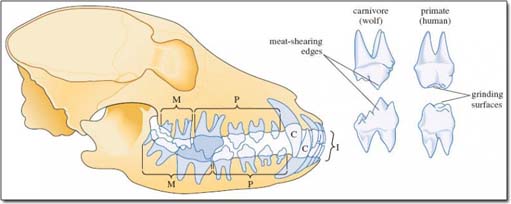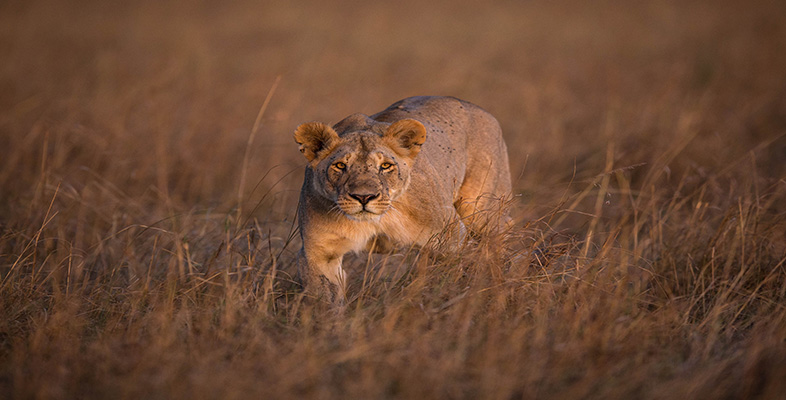2.2 What are the common features of Carnivora?
As LoM and the TV programme reveal, there is great variation in the size and shape of carnivores and also in their lifestyle and behaviour. They have a worldwide distribution - from arctic foxes to equatorial lions. Some (like bears) walk on the soles of the feet (plantigrade) and others such as dogs walk on their toes (digitigrade). All have a fusion of certain bones in the wrist; in non-Carnivora, like ourselves, these three bones of the wrist (the names needn't concern us) are independent. All carnivores have a characteristically small collar bone (or clavicle). Shared characteristics of this sort enabled earlier naturalists to deduce a common evolutionary ancestry - an origin more recently confirmed by modern DNA studies.
As DA writes, the teeth of carnivores are both hunters' weapons and butchers' tools. Figure 2 shows the skull and lower jaw of a carnivore - in this instance, a member of the dog family - and you'll be familiar with the terminology used. The canine (C) and incisor (I) teeth are used for killing prey and also for display and defence. Behind these are the premolars (P), which are used in some species, like hyenas, to crush food and in others, like dogs, to pierce food. The famous carnassial teeth are the fourth upper premolar and the first lower molar on each side. These scissor-blade-like teeth are positioned towards the back of the mouth - so that meat between them can be subjected to the greatest force in just the same sort of position as you would put something really tough in the jaws of a pair of scissors. The carnassials are thought to be of particular evolutionary significance, almost certainly present in the ancestors of carnivores. They are especially prominent in felids and some mustelids (i.e. members of the cat and weasel family, respectively) and in hyenas. In those carnivores that are more inclined to plant-eating (notably pandas) these teeth have surfaces more suited to grinding. But in general, carnivores use the back molar teeth (M) for grinding tough foods, and these teeth are particularly well developed in bears.

SAQ 3
Question: What is the dental formula (see course S182_2) for the carnivore in Figure 2?
Answer
I3/3, C1/1, P4/4, M2/3; a total of 42 teeth.
Many carnivores have a complement of 44 teeth, with three molars on the upper jaw. But there is a good deal of variation in the dental formula of the different carnivore families. The domestic cat has the dental formula: I3/3, C1/1, P2/2, M1/1.
You will appreciate why many carnivores have powerful jaw muscles; for example, in the large cats (e.g. lions) great force is needed to provide the pressure for suffocating prey when they grip its throat (see photo in LoM p. 152) and also for crushing bones when the mouth is open. Another set of jaw muscles (the masseter muscle) provides the force to cut flesh and to grind food when the jaws are almost closed.
Activity 2
Watch the TV programme from 01.11-02.59, which shows the capture and killing of a rabbit by a stoat, and lion hunting. Make notes on how the lioness brings down the wildebeest and suffocates it. Apart from the obvious differences of scale, how do the two killing techniques differ? (Look again too at the dramatic photograph in LoM p. 152.)
Answer
Stoats generally kill rabbits by (in DA's words) 'stabbing their fangs (i.e. their canines) into the back of the rabbit's neck (a strike only just visible in the TV sequence), which has the effect of smashing the rear end of its skull' [p. 124]. In the programme the lioness first brings down the prey and although it attaches by biting the back of the neck, you can see that it kills by suffocation, using canines and incisors, crushing the prey's windpipe. (Tigers more often kill with a crushing bite to the back of the prey's neck.)
Although, in the main, lions prey on large, hoofed mammals, they are known to take animals as small as rodents, hares, birds and reptiles. Table 2 categorises the diet of a range of carnivores - those carnivores that deviate most strongly from meat eating (e.g. raccoon, brown bear) are covered in the next course in this series, following the logic of DA's approach in LoM. Where plant material is abundant in the diet the molars have a 'pestle and mortar' design, used to fragment plant material into small particles.
| Dietary category | Type of food | Examples |
|---|---|---|
| meat | more than 70% freshly killed prey (including offal, brains, etc.) | lynx, lion, tiger, jaguar, puma, cheetah, polar bear |
| meat/bone | more than 70% meat with addition of large bones | spotted hyena, striped hyena |
| meat/non-vertebrate | 50-70% prey and carrion, with fruit, nuts and/or insects making up the balance | fox, badger, polar bear, coyote, jackal |
| non-vertebrate/meat | less than 50% vertebrate prey, with fruit and/or insects predominating | raccoon, brown bear, black bear |

SAQ 4
Question: Figure 3, above, shows the jaw bones of the spotted hyena, the brown bear and the puma, but not necessarily in that order. Examine the figure and, together with the information in Table 2, identify which diagram relates to each of these three animals. Explain your reasoning.
Answer
The bear is (c); as mentioned earlier, the molars here are well developed and offer a substantial grinding surface. Table 2 shows that the puma has a higher meat content in its diet than the spotted hyena, so you'd expect the flesh-shearing carnassials to be prominent and sharply angled, as in (a). In the spotted hyena, strong premolars, as in (b), are linked with its ability to crush bones. (The carnassials of the spotted hyena are especially important in slicing and shearing the hides of its prey - an ability that few other large carnivores have.)
There are often trade-offs between costs and benefits in mammalian lifestyles. What are the advantages and disadvantages of a mainly meat diet? DA describes it as 'the most energy-packed of all foods' [p. 124]. A modest portion of meat (100 grams) may well contain 800 kilojoules of energy, but the same mass of fruit contains only 200-400 kJ; an equivalent amount of foliage has just 40-80 kJ.
The digestive chemistry of converting prey flesh and bone into predator flesh and bone is much simpler than that needed to convert vegetation to flesh. Flesh eaters, like lynx and wildcat, have a shorter intestine than herbivores - only four times the length of the body; foxes and wolves, which sometimes eat plant materials have an intestine five times the body length and herbivores have even longer intestines. For example, the intestines of Grevy's zebras are 11-12 times the body length, that of the plains zebra 17 times.
But is meat eating all benefits and no costs? Plants are much more abundant and easily caught, which means that less energy is expended in feeding by herbivores. Bones are hard to chew and digest and bone splinters can damage the gut. The spotted hyena's stomach makes a great deal of hydrochloric acid, which dissolves bone and releases nutrients; cats voluntarily vomit to get rid of sharp bones. These examples reveal the complex systems associated with carnivory, which in many respects is a more risky and competitive way of life, as the next sections will illustrate.
